The Development of an Efficient Simplified Technique to Estimate Diffusivity in a Completely Mixed Batch Reactor
Abstract
1. Introduction
2. Materials and Methods
2.1. Fundamental Equations of R Technique
- Intra-Particle Diffusion
- Fluid-to-Solid Film Transfer
- Interface Transfer
- Mass Balance within Vessel
- Average Amount Adsorbed
- Equilibrium Relationship
- First Item Intra-Particle Diffusion
- Fluid-to-Solid Film Transfer
- Interface Transfer
- Mass Balance within Vessel
- Average Amount Adsorbed
- Equilibrium Relationship
2.2. Fundamental Equations of S Technique
- Intra-Particle Diffusion
- Mass Balance within Vessel
- Average Amount Adsorbed
- Equilibrium Relationship
3. Results and Discussion
3.1. R Technique
3.2. S Technique
3.3. ES Technique
4. Conclusions
Author Contributions
Funding
Institutional Review Board Statement
Informed Consent Statement
Data Availability Statement
Conflicts of Interest
Nomenclature
| Bi | Biot number, |
| aP | Surface area based on solid particle [cm2/cm3] |
| c0 | Concentration within vessel at time, 0 [mmol/cm3] |
| ce | Equilibrium concentration at time, infinity [mmol/cm3] |
| cs | Concentration at interface between solid and fluid-to-solid film [mmol/cm3] |
| Cs | Dimensionless cs, |
| ct | Concentration within vessel at time, t [mmol/cm3] |
| Ct | Dimensionless ct, |
| Ds | Effective surface diffusivity (based on solid concentration difference) [cm2/s] |
| Ds,rig | Effective surface diffusivity estimated using R technique [cm2/s] |
| Ds,sim | Effective surface diffusivity estimated using S technique [cm2/s] |
| Ds,eff | Effective surface diffusivity estimated using ES technique [cm2/s] |
| k | Freundlich constant [(mmol/g) (cm3/mmol)n] |
| kF | liquid film mass transfer coefficient [cm2/s] |
| m | Weight of adsorbent [g] |
| 1/n | Freundlich exponent [-] |
| q0 | Amount adsorbed in equilibrium with fluid concentration, c0 [mmol/g] |
| qint | Initial amount adsorbed at t = 0 [mmol/g] |
| qm | Amount adsorbed at r = r [mmol/g] |
| Qm | Dimensionless qm, |
| qt | Average amount adsorbed within a solid particle at time, t [mmol/g] |
| Qt | Dimensionless qt, |
| r | Internal radial length (length from solid center) [cm] |
| rp | Particle radius [cm] |
| R | Dimensionless internal radial length, |
| t | Time [s] |
| T | Dimensionless time, |
| V | Volume of vessel [cm3] |
References
- Fan, H.-J.; Anderson, P.R. Copper and cadmium removal by Mn oxide-coated granular activated carbon. Sep. Purif. Technol. 2005, 45, 61–67. [Google Scholar] [CrossRef]
- Fujiki, J.; Sonetaka, N.; Ko, K.P.; Furuya, E. Experimental determination of intraparticle diffusivity and fluid film mass transfer coefficient using batch contactors. Chem. Eng. J. 2010, 160, 683–690. [Google Scholar] [CrossRef]
- Al-Khateeb, L.A.; Almotiry, S.; Salam, M.A. Adsorption of pharmaceutical pollutants onto graphene nanoplatelets. Chem. Eng. J. 2014, 248, 191–199. [Google Scholar] [CrossRef]
- Dotto, G.L.; McKay, G. Current scenario and challenges in adsorption for water treatment. J. Environ. Chem. Eng. 2020, 8, 103988. [Google Scholar] [CrossRef]
- Souza, P.; Dotto, G.; Salau, N. Experimental and mathematical modeling of hindered diffusion effect of cationic dye in the adsorption onto bentonite. J. Environ. Chem. Eng. 2019, 7, 102891. [Google Scholar] [CrossRef]
- Franco, D.S.; Martinello, K.d.B.; Georgin, J.; Netto, M.S.; Foletto, E.L.; Silva, L.F.; dos Reis, G.S.; Dotto, G.L. Pore volume and surface diffusion model (PVSDM) applied for single and binary dye adsorption systems. Chem. Eng. Res. Des. 2022, 182, 645–658. [Google Scholar] [CrossRef]
- Ansari, K.B.; Danish, M.; Khatoon, A.; Rao, R.A.K.; Zaidi, S.; Aftab, R.A. A comprehensive investigation of external mass transfer and intraparticle diffusion for batch and continuous adsorption of heavy metals using pore volume and surface diffusion model. Sep. Purif. Technol. 2022, 292, 120996. [Google Scholar]
- Sonetaka, N.; Fan, H.-J.; Kobayashi, S.; Chang, H.-N.; Furuya, E. Simultaneous determination of intraparticle diffusivity and liquid film mass transfer coefficient from a single-component adsorption uptake curve. J. Hazard. Mater. 2009, 164, 1447–1451. [Google Scholar] [CrossRef] [PubMed]
- Kawakita, T.; Fan, H.-J.; Seida, Y.; Fujiki, J.; Furuya, E. A simplified technique to determine intraparticle diffusivity of macro-reticular resins. Sustain. Environ. Res. 2016, 26, 249–254. [Google Scholar] [CrossRef]
- Aguwa, A.A.; Patterson, J.W.; Haas, C.N.; Noll, K.E. Estimation of Effective Intraparticle Diffusion Coefficients with Differential Reactor Columns. J. (Water Pollut. Control Fed.) 1984, 56, 442–448. [Google Scholar]
- Kawakita, T.; Fan, H.-J.; Seida, Y.; Kinoshita, T.; Furuya, E. A simple method for the determination of adsorption kinetic parameters using circulating-type shallow bed reactor (CSBR). Desalination Water Treat. 2017, 92, 1–8. [Google Scholar] [CrossRef]
- Satoh, K.; Fan, H.-J.; Hattori, H.; Tajima, K.; Furuya, E. Simultaneous determination of intraparticle diffusivities from ternary component uptake curves using the shallow bed technique. J. Hazard. Mater. 2008, 155, 397–402. [Google Scholar] [CrossRef] [PubMed]
- Fujiki, J.; Shinomiya, T.; Kawakita, T.; Ishibashi, S.; Furuya, E. Experimental determination of fluid-film mass transfer coefficient from adsorption uptake curve. Chem. Eng. J. 2011, 173, 49–54. [Google Scholar] [CrossRef]
- Sonetaka, N.; Seida, Y.; Nakano, T.; Furuya, E. Determination of intraparticle diffusivity and fluid-to-solid mass transfer coefficient from single concentration history curve in circulated-type fixed-bed reactor. Adsorpt. Sci. Technol. 2017, 36, 571–585. [Google Scholar] [CrossRef]
- Suzuki, M.; Kawazoe, K. Batch measurement of adsorption rate in an agitated tank pore diffusion kinetics with irreversible isotherm. J. Chem. Eng. Jpn. 1974, 7, 346–350. [Google Scholar] [CrossRef]
- Furuya, E.G.; Chang, H.T.; Miura, Y.; Yokomura, H.; Tajima, S.; Yamashita, S.; Noll, K.E. Intraparticle mass transport mechanism in activated carbon adsorption of phenols. J. Environ. Eng. 1996, 122, 909–916. [Google Scholar] [CrossRef]
- Fujiki, J.; Noll, K.E.; Kawakita, T.; Nakane, Y.; Furuya, E. Simplified determination method of intraparticle diffusivity within a resin adsorbent from binary-component liquid adsorption uptake curves. Transp. Porous Media 2014, 102, 349–364. [Google Scholar] [CrossRef]

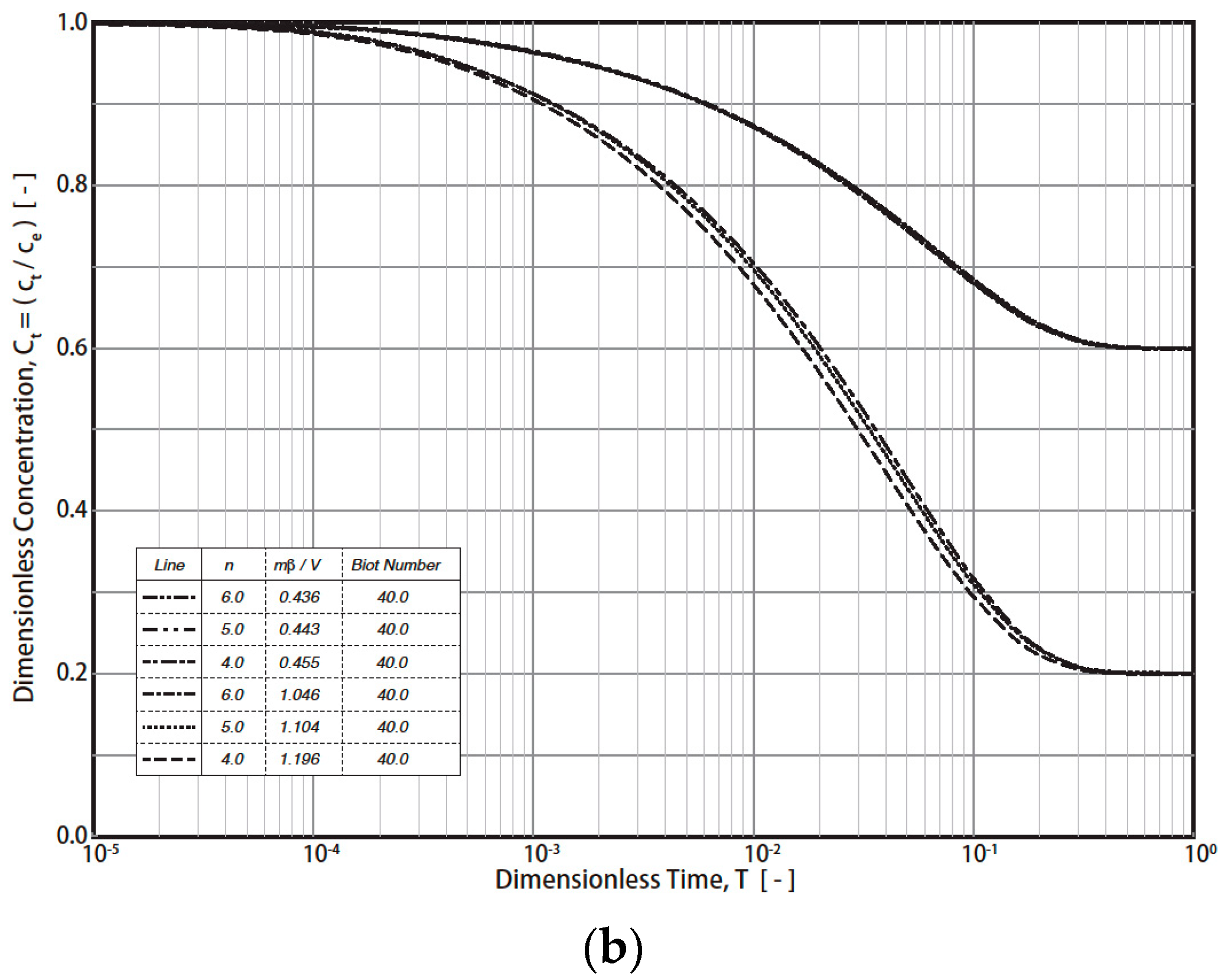
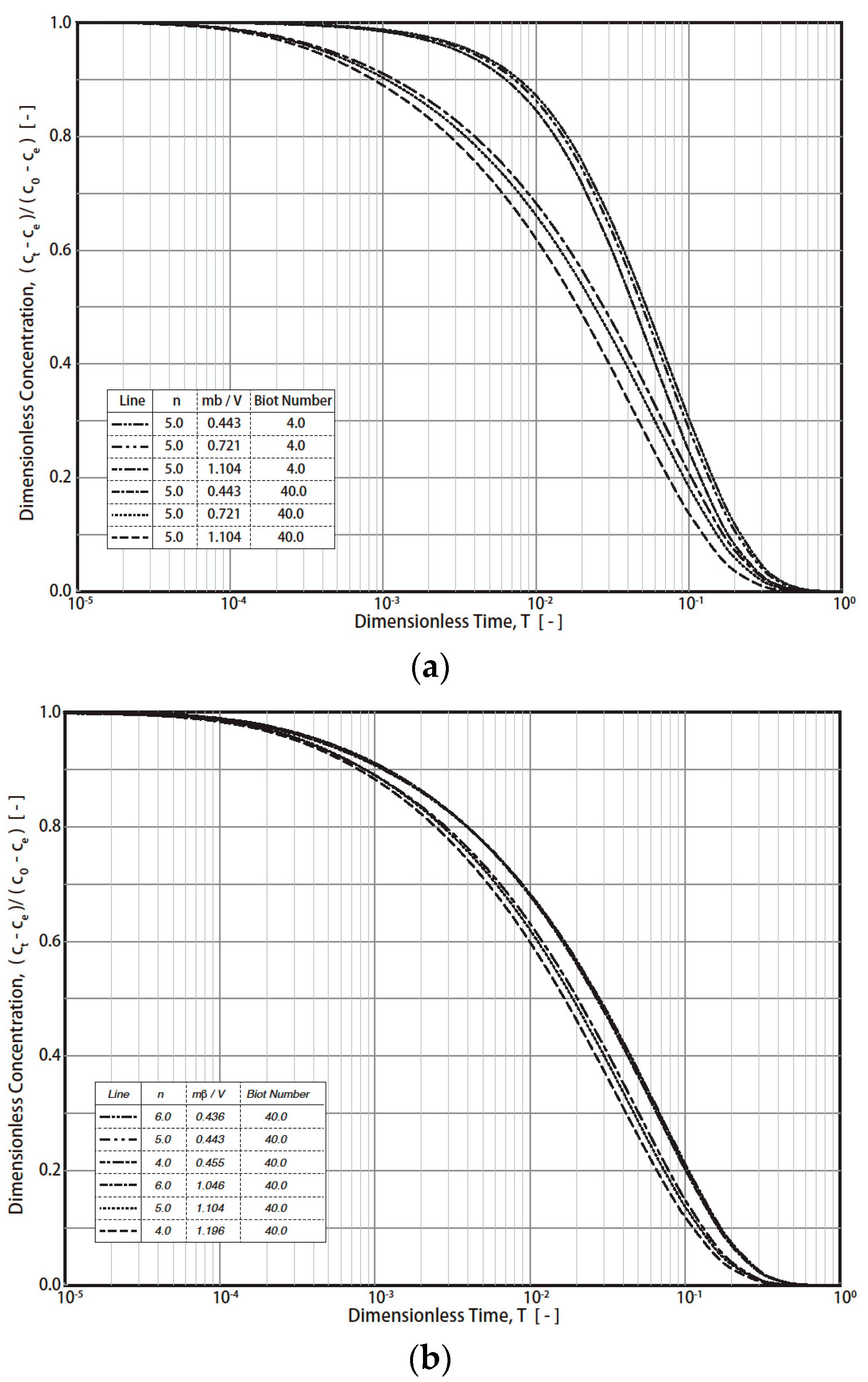

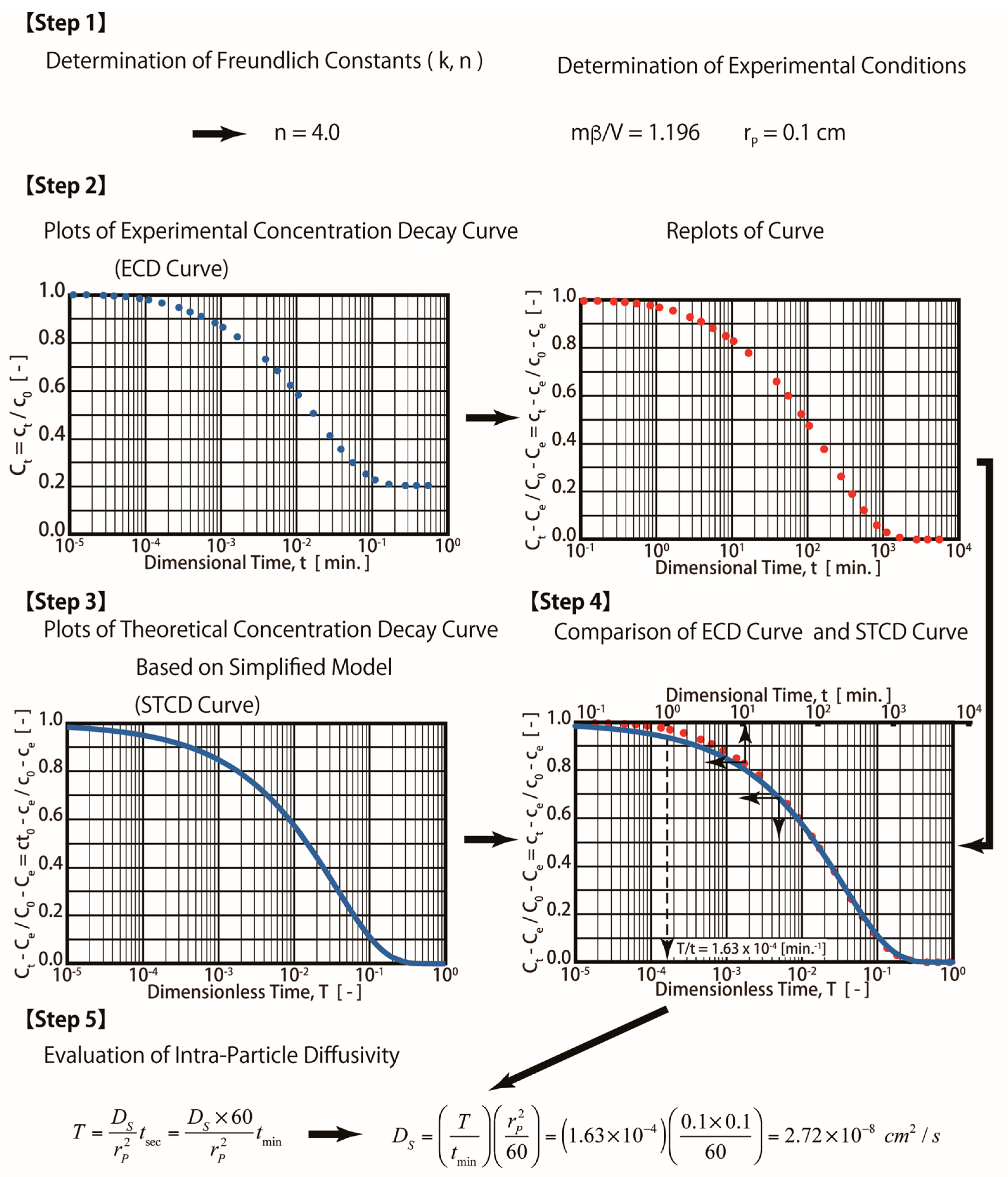

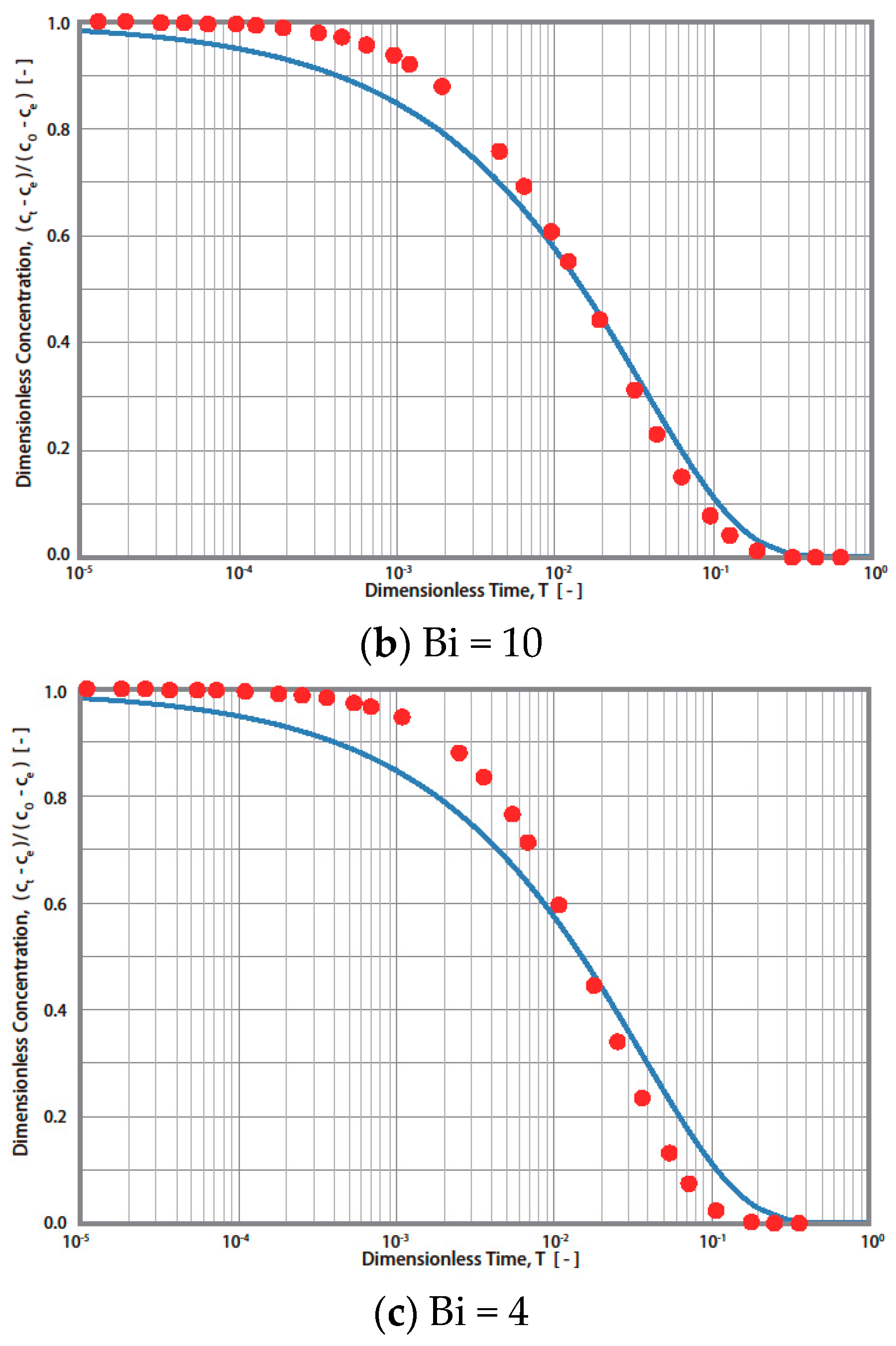
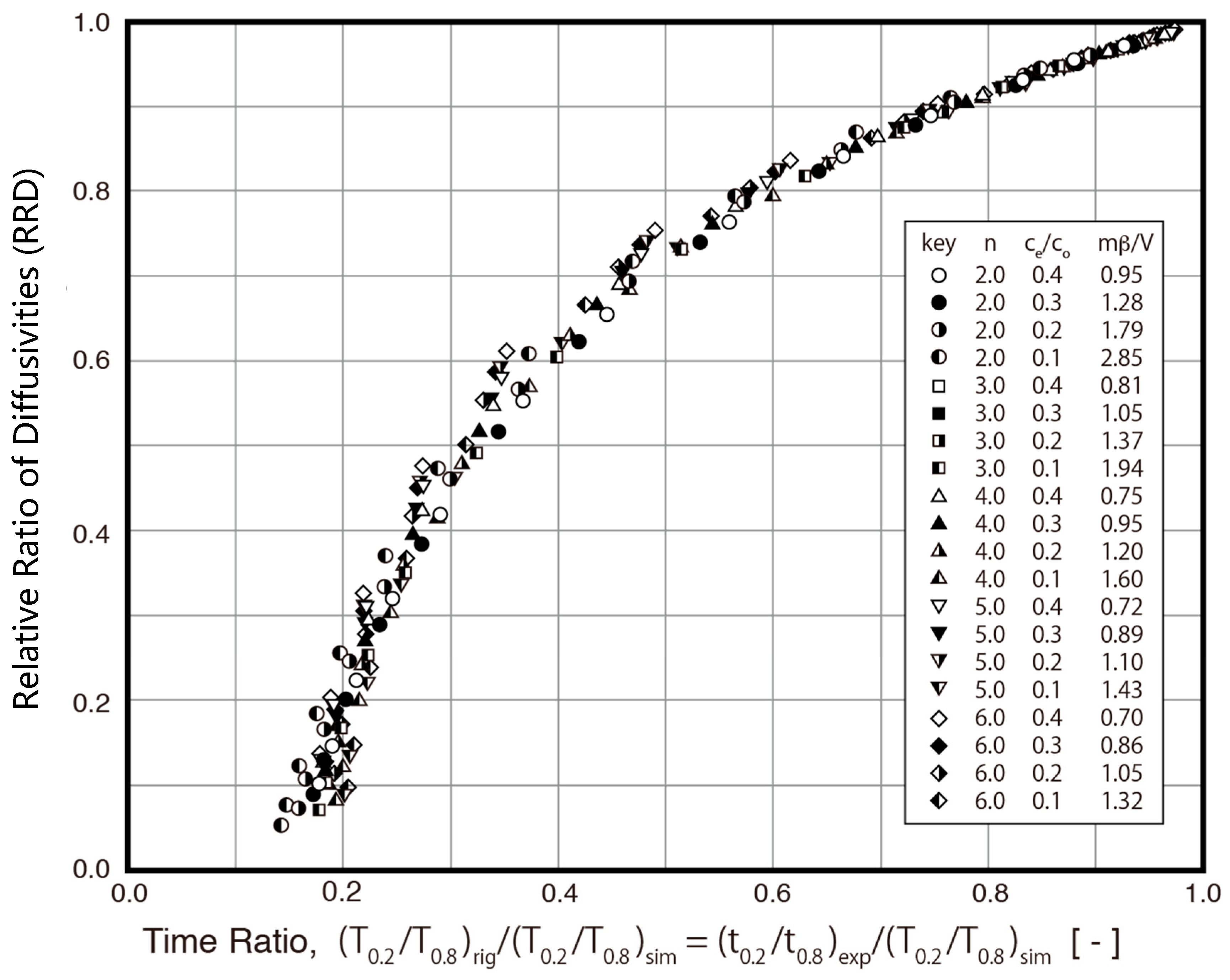
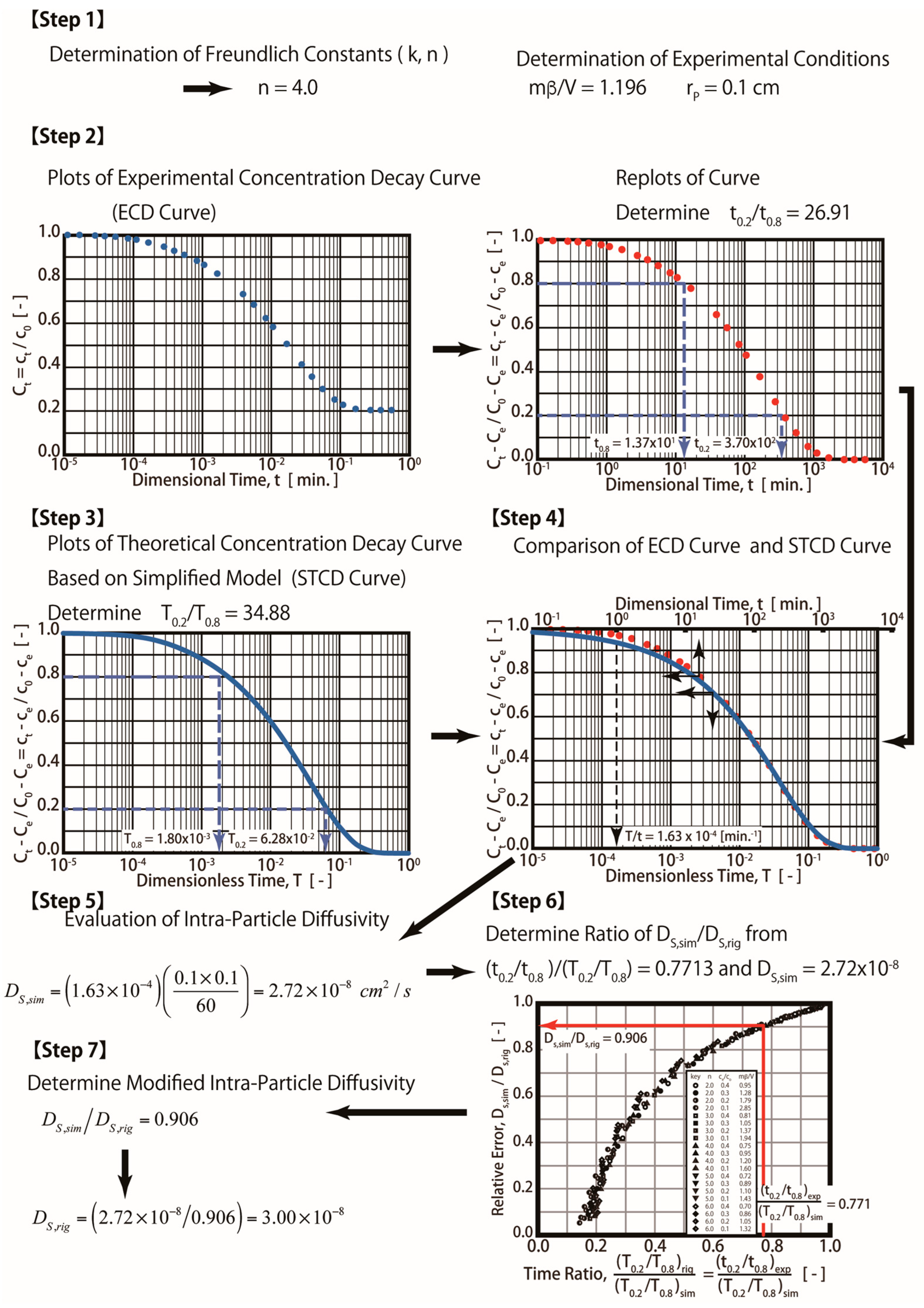
| Case 1: Surface diffusion-controlled conditions (Biot number = 40) | |||
| Rigorous Technique | Simplified Technique | Efficient Simplified Technique | |
| t0.2/t0.8 | 26.91 | 26.91 | 26.91 |
| T0.2/T0.8 | 26.91 | 34.88 | 34.88 |
| T/t | 1.80 × 10−4 | 1.63 × 10−4 | 1.63 × 10−4 |
| (t0.2/t0.8)/(T0.2/T0.8) | - | - | 7.73 × 10−1 |
| Ds [cm2/s} | 3.00 × 10−8 (2) | 2.72 × 10−8 (3) | 3.00 × 10−8 (4) |
| Estimation error (%) (1) | - | 9.33% | 0.00% |
| Case 2: Condition of both surface diffusion and fluid film resistance are important (Biot number = 10) | |||
| Rigorous Technique | Simplified Technique | Efficient Simplified Technique | |
| t0.2/t0.8 | 14.66 | 14.66 | 14.66 |
| T0.2/T0.8 | 14.66 | 34.88 | 34.88 |
| T/t | 1.80 × 10−4 | 1.14 × 10−4 | 1.14 × 10−4 |
| (t0.2/t0.8)/(T0.2/T0.8) | - | - | 4.20 × 10−1 |
| Ds [cm2/s} | 3.00 × 10−8 | 1.90 × 10−8 | 2.90 × 10−8 |
| Estimation error (%) | - | 36.67% | 3.33% |
| Case 3: Fluid film controlled condition (Biot number = 4) | |||
| Rigorous Technique | Simplified Technique | Efficient Simplified Technique | |
| t0.2/t0.8 | 9.09 | 9.09 | 9.09 |
| T0.2/T0.8 | 9.09 | 34.88 | 34.88 |
| T/t | 1.80 × 10−4 | 6.50 × 10−5 | 6.50 × 10−5 |
| (t0.2/t0.8)/(T0.2/T0.8) | - | - | 2.61 × 10−1 |
| Ds [cm2/s} | 3.00 × 10−8 | 1.08 × 10−8 | 2.90 × 10−8 |
| Estimation error (%) | - | 64.00% | 3.33% |
Disclaimer/Publisher’s Note: The statements, opinions and data contained in all publications are solely those of the individual author(s) and contributor(s) and not of MDPI and/or the editor(s). MDPI and/or the editor(s) disclaim responsibility for any injury to people or property resulting from any ideas, methods, instructions or products referred to in the content. |
© 2024 by the authors. Licensee MDPI, Basel, Switzerland. This article is an open access article distributed under the terms and conditions of the Creative Commons Attribution (CC BY) license (https://creativecommons.org/licenses/by/4.0/).
Share and Cite
Koike, Y.; Fan, H.-J.; Seida, Y.; Sonetaka, N.; Furuya, E. The Development of an Efficient Simplified Technique to Estimate Diffusivity in a Completely Mixed Batch Reactor. Appl. Sci. 2024, 14, 4903. https://doi.org/10.3390/app14114903
Koike Y, Fan H-J, Seida Y, Sonetaka N, Furuya E. The Development of an Efficient Simplified Technique to Estimate Diffusivity in a Completely Mixed Batch Reactor. Applied Sciences. 2024; 14(11):4903. https://doi.org/10.3390/app14114903
Chicago/Turabian StyleKoike, Yuya, Huan-Jung Fan, Yoshimi Seida, Noriyoshi Sonetaka, and Eiji Furuya. 2024. "The Development of an Efficient Simplified Technique to Estimate Diffusivity in a Completely Mixed Batch Reactor" Applied Sciences 14, no. 11: 4903. https://doi.org/10.3390/app14114903
APA StyleKoike, Y., Fan, H.-J., Seida, Y., Sonetaka, N., & Furuya, E. (2024). The Development of an Efficient Simplified Technique to Estimate Diffusivity in a Completely Mixed Batch Reactor. Applied Sciences, 14(11), 4903. https://doi.org/10.3390/app14114903








